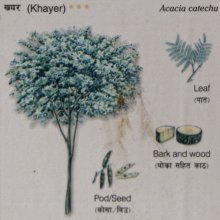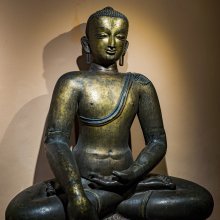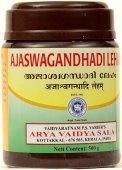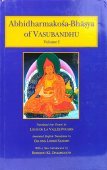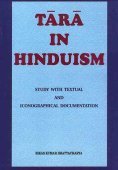Kosha, Kośa, Kosa, Kośā, Koṣā, Kōṣā: 34 definitions
Introduction:
Kosha means something in Buddhism, Pali, Hinduism, Sanskrit, the history of ancient India, Marathi, Jainism, Prakrit, Hindi, biology, Tamil. If you want to know the exact meaning, history, etymology or English translation of this term then check out the descriptions on this page. Add your comment or reference to a book if you want to contribute to this summary article.
The Sanskrit terms Kośa and Kośā and Koṣā and Kōṣā can be transliterated into English as Kosa or Kosha, using the IAST transliteration scheme (?).
Alternative spellings of this word include Kosh.
Images (photo gallery)
In Hinduism
Vedanta (school of philosophy)
Source: archive.org: Mandukya Upanishad & Karika with Shankara BhashyaThe five sheaths (kośa) are:
- the Annamayakośa (the physical sheath),
- the Prāṇamayakośa (the vital sheath),
- the Manomayakośa (the mental sheath),
- the Vijñānamayakośa (the sheath of intellect)
- and the Ānandamayakośa (the sheath of Bliss).
The Kośas are compared to sheaths. As the sheath is external to the sword, so also the kośas are external to the Ātman which is the innermost Self of all. The Annamayakośa is the sheath wherein is encased the Prāṇamayakośa, the Prāṇamayakośa is the sheath wherein is encased the Manomayakośa and so on. The Ānandamayakośa is encased in the Vijñānamayakośa.
Source: Shodhganga: Siva Gita A Critical StudyKośa (कोश) refers to “sheath: vessel, container; layer, vesture”.—Philosophically, five sheaths through which the soul functions simultaneously in the various planes or levels of existence.
The kośas are:—
- annamaya-kośa (“sheath composed of food”),
- prāṇamaya-kośa (“sheath composed of prāṇa or vital force),
- manomaya-kośa (“mind-formed sheath”),
- vijñānamaya-kośa (“sheath of cognition”),
- ānandamaya-kośa (“body of bliss”).
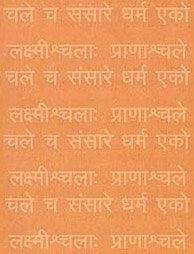
Vedanta (वेदान्त, vedānta) refers to a school of orthodox Hindu philosophy (astika), drawing its subject-matter from the Upanishads. There are a number of sub-schools of Vedanta, however all of them expound on the basic teaching of the ultimate reality (brahman) and liberation (moksha) of the individual soul (atman).
Dharmashastra (religious law)
Source: Wisdom Library: Dharma-śāstraKoṣa (कोष) refers to “treasury” It is used throughout Dharmaśāstra literature such as the Manusmṛti and the Baudhāyana-dharmasūtra.
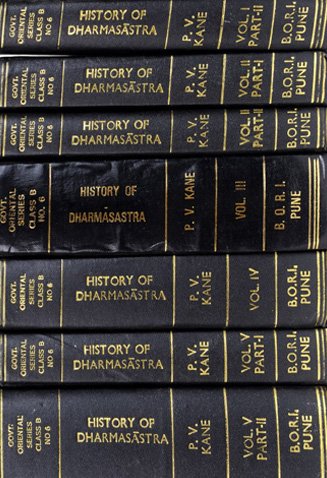
Dharmashastra (धर्मशास्त्र, dharmaśāstra) contains the instructions (shastra) regarding religious conduct of livelihood (dharma), ceremonies, jurisprudence (study of law) and more. It is categorized as smriti, an important and authoritative selection of books dealing with the Hindu lifestyle.
Purana and Itihasa (epic history)
Source: archive.org: Puranic EncyclopediaKoṣā (कोषा).—A river. It is stated in Mahābhārata, Bhīṣma Parva, Chapter 9, Stanza 27, that the water of this river was used for drinking by the ancient people of Bhārata.
Source: Cologne Digital Sanskrit Dictionaries: The Purana IndexKośā (कोशा).—Of Kāśi king.*
- * Viṣṇu-purāṇa V. 34. 42.

The Purana (पुराण, purāṇas) refers to Sanskrit literature preserving ancient India’s vast cultural history, including historical legends, religious ceremonies, various arts and sciences. The eighteen mahapuranas total over 400,000 shlokas (metrical couplets) and date to at least several centuries BCE.
Kavya (poetry)
Source: Shodhganga: Mankhaka a sanskrit literary geniusKoṣa (कोष).—The Sanskrit koṣa texts or the Sanskrit lexicography had a very old origin. It primarily means dictionary or lexicon. The lexicographers always emphasize that they have written their works, for the utilization of the poets. Thus, the study of the koṣas is closely associated with that of the kāvyas.
Source: OpenEdition books: Vividhatīrthakalpaḥ (Kāvya)Kośā (कोशा) is the name of a courtesan, as mentioned in the Vividhatīrthakalpa by Jinaprabhasūri (13th century A.D.): an ancient text devoted to various Jaina holy places (tīrthas).—Cf. Āvasyakaniryukti (Haribhadra commentary) b.6-b.6; Paris. VIII. v. 109-169; Leumann 1934 p. 27.33-60.

Kavya (काव्य, kavya) refers to Sanskrit poetry, a popular ancient Indian tradition of literature. There have been many Sanskrit poets over the ages, hailing from ancient India and beyond. This topic includes mahakavya, or ‘epic poetry’ and natya, or ‘dramatic poetry’.
Shaktism (Shakta philosophy)
Source: Google Books: Manthanabhairavatantram1) Kośa (कोश) refers to the “treasure” (of mantras), according to the Manthānabhairavatantra, a vast sprawling work that belongs to a corpus of Tantric texts concerned with the worship of the goddess Kubjikā.—Accordingly, “[...] The Seat of Yoga, which is the Heart of the Goddess (AIṂ), (is formed) by (their) conjunction. Pure, it consists of the three and a half measures (of Speech). [...] That mantra (ŚRĪṂ) which is in Pūrṇagiri is in the abode of Śiva’s energy and is the treasure of mantras [i.e., mantra-kośa] that has been filled (with it)”.
2) Koṣa (कोष) refers to a “container (of the supreme state)”, according to the Śrīmatottara-tantra, an expansion of the Kubjikāmatatantra: the earliest popular and most authoritative Tantra of the Kubjikā cult.—Accordingly, “Abandon (both) form (rūpa) and the formless. Practice what is beyond form. All this (divine body) is in the form of a container (of the supreme state) [i.e., koṣa-ākāra]. It is the radiant energy which is all things. One who desires the (supreme) good should abandon everything. It is as useless as rotten meat. O god, there is nothing at all (of deity) in the navel, heart, mouth, and nose, nothing at all between the eyebrows, forehead, in the middle of the palate, or within the uvula, head and eyes. [...]”.

Shakta (शाक्त, śākta) or Shaktism (śāktism) represents a tradition of Hinduism where the Goddess (Devi) is revered and worshipped. Shakta literature includes a range of scriptures, including various Agamas and Tantras, although its roots may be traced back to the Vedas.
Jyotisha (astronomy and astrology)
Source: Wisdom Library: Brihat Samhita by VarahamihiraKośa (कोश) or Kośabhavana refers to “store-houses”, according to the Bṛhatsaṃhitā (chapter 16) (“On the planets—graha-bhaktiyoga”), an encyclopedic Sanskrit work written by Varāhamihira mainly focusing on the science of ancient Indian astronomy astronomy (Jyotiṣa).—Accordingly, “[...] Mars presides over citizens, farmers, chemists, firemen, soldiers, forest-men, citadels, chief towns, butchers, sinners, haughty men, kings, children, elephants, fops, infanticides, shepherds, red fruits, red flowers, corals, commanders of armies, jaggery, wine, cruel men, storehouses (kośa-bhavana), Agnihotrins, metal mines, the Śākyas in red robes, the Buddhists, thieves, rogues, vindictive and gluttonous persons. [...]”.

Jyotisha (ज्योतिष, jyotiṣa or jyotish) refers to ‘astronomy’ or “Vedic astrology” and represents the fifth of the six Vedangas (additional sciences to be studied along with the Vedas). Jyotisha concerns itself with the study and prediction of the movements of celestial bodies, in order to calculate the auspicious time for rituals and ceremonies.
General definition (in Hinduism)
Source: Google Books: The Primal Power in Man: The Kundalini ShaktiThe Jiva is enveloped by five sheaths (Kosas), viz., Annamaya, Pranamaya, Manomaya, Vijnanamaya, Anandamaya Kosas:—
- Annamaya Kosa:– Annamaya Kosa (sheath) is the physical body, which is sustained by food (Anna). Annamaya Kosa is the outcome of Tamo-Guna. Tamo-Guna predominates in this Kosa and Tamo-Guna is the cause of this Kosa. Inertness is found to ppredominate in this Kosa.
- Pranamaya Kosa:– Pranamaya Kosa consists of the subtle body, with the five gross and five subtle senses, ten Pranas or five vital forces and finve minor Vayus. Rajo-Guna is the cause of this Kosa and Rajo-Guna predominates in this Kosa. The power of action (Kriya Shakti) inheres in this Kosa.
- Manomaya Kosa:– Manomaya Kosa consists of the mind, with the five subtle senses. This Kosa is the outcome of Sattva-Guna. Sattva-Guna predominates in this Kosa. The power of cognition inheres in this Kosa. So we see that the mind is mixed with Tamas qualities, such as love, attachment, hatred, anger, envy, etc.
- Vijnanamaya Kosa:– Vijnanamaya Kosa consists of the Buddhi (intellect) with the five subtle senses. In this Kosa, Sattva mixed with Rajo-Guna inheres. Sattva mixed with Rajo-Guna is the cause of this Kosa.
- Anandamaya Kosa:– Anandamaya Kosaconsists of the Jiva with the causal body. Sattva-Guna is the cause of this Kosa. The principle of the purity of the Sattva-Guna lives in a sullied state by the other two Gunas together with the three conditions of happiness called Priya, Moda, and Pramoda. It contains joys of various kinds.
A Kosha (कोश), usually rendered "sheath", one of five coverings of the Atman, or Self according to Vedantic philosophy. They are often visualised as the layers of an onion.
The five sheaths (pancha-kosas) are described in the Taittiriya Upanishad. From gross to fine they are:
- Annamaya kosha, "foodstuff" sheath (Anna)
- Pranamaya kosha, "energy" sheath (Prana/apana)
- Manomaya kosha "mind-stuff" sheath (Manas)
- Vijnanamaya kosha, "wisdom" sheath (Vijnana)
- Anandamaya kosha, "bliss" sheath (Ananda)
A human being is part consciousness (Atma - soul) wrapped in 5 layers known as Panchakosha in Vedanta. The layers are
- Physical Body (Annmaya Kosha),
- Energy Body (Pranamaya Kosha),
- Mind Body (Manomaya Kosha),
- Intuition Body (Vigyanmaya Kosha),
- and Joy Body (Anandmaya Kosha).
In Buddhism
General definition (in Buddhism)
Source: Ananda Marga: Realsm of the MindKosa means "layer of mind." There are five layers of the human mind, in addition to the physical body, which—although technically not a kosa itself—is given the name Annamaya ("food") Kosa.
- Kamamaya Kosa (The Crude Mind)
- Manomaya Kosa (The Subtle Mind)
The next three deeper layers of mind are collectively known as the Causal Mind. Causal sig - nifies that these layers are in the most direct contact with the Causal Consciousness from which the mind has evolved and within which it exists.
- Atimanasa Kosa (The first layer of the Causal Mind)
- Vijnanamaya Kosa (The second layer of the Causal Mind)
- Hiranyamaya Kosa (The most subtle layer of the Causal Mind).
India history and geography
Source: Cologne Digital Sanskrit Dictionaries: Indian Epigraphical GlossaryKoṣa.—treasure, see Ghoshal, H. Rev. Syst., pp. 15-16. Note: koṣa is defined in the “Indian epigraphical glossary” as it can be found on ancient inscriptions commonly written in Sanskrit, Prakrit or Dravidian languages.
Source: Singhi Jain Series: Ratnaprabha-suri’s Kuvalayamala-katha (history)Kośa (कोश) is the name of a Kathā (“narrative poem”) written by Hāla (Sālāhaṇa), as mentioned by Uddyotanasūri in his 8th-century Kuvalayamālā (a Prakrit Campū, similar to Kāvya poetry) narrating the love-story between Prince Candrāpīḍa and the Apsaras Kādambarī.—The Kuvalayamala (779 A.D.) is full of cultural material which gains in value because of the firm date of its composition. [...] On pages 3.18-4.12, Uddyotanasūri gives the names of a number of Kathās and their authors, in Sanskrit, Prakrit and Apabhramsha, [i.e., Hāla (Sālāhaṇa) and his Kośa], [...]—That was the usual practice of all writers like Subandhu, Bāṇa, Daṇḍin, Haribhadra, Svayaṃbhū etc. We are able to know the names of about fifty works including romances. Dr. A. N. Upadhye has dealt with these in his paper entitled “Works and Authors referred to in the Kuvalayamālā of Uddyotanasūri” submitted to the A.I.O.C. Session at Gauhati.
Source: Yale Journal of Music & Religion: Ritual Music in Contemporary Brahmanical Tantric Temples of KeralaKośa (कोश) or Pañcakośa refers to the “five sheaths” of the Human Body which corresponds to the Pañcaprākāra (five enclosures) of the Temple.—The five sheaths are: the physical sheath (annamaya-kośa), the vital body sheath (prāṇamaya-kośa), the mental sheath (manomaya-kośa), the intellectual sheath (vijñānamaya-kośa), and the bliss sheath (anandamaya-kośa). These five sheaths represent the physical body of the deity on the horizontal plane. as the five enclosures of the temple represent the five sheaths (kośas) of the deity in space, the five kālams of pañcāri-mēḷam reproduce the five sheaths (kośas) in time. In other words, this composition is a sonic representation of the body of the deity.

The history of India traces the identification of countries, villages, towns and other regions of India, as well as mythology, zoology, royal dynasties, rulers, tribes, local festivities and traditions and regional languages. Ancient India enjoyed religious freedom and encourages the path of Dharma, a concept common to Buddhism, Hinduism, and Jainism.
Biology (plants and animals)
Source: Google Books: CRC World Dictionary (Regional names)Kosha in India is the name of a plant defined with Artocarpus integrifolius in various botanical sources. This page contains potential references in Ayurveda, modern medicine, and other folk traditions or local practices It has the synonym Artocarpus integrifolia L.f..
Example references for further research on medicinal uses or toxicity (see latin names for full list):
· Supplementum Plantarum Systematis Vegetabilium Editionis Decimae Tertiae (1782)
If you are looking for specific details regarding Kosha, for example side effects, chemical composition, health benefits, extract dosage, pregnancy safety, diet and recipes, have a look at these references.

This sections includes definitions from the five kingdoms of living things: Animals, Plants, Fungi, Protists and Monera. It will include both the official binomial nomenclature (scientific names usually in Latin) as well as regional spellings and variants.
Languages of India and abroad
Pali-English dictionary
Source: BuddhaSasana: Concise Pali-English Dictionarykosa : (m.) store-room; treasury; a sheath; a cocoon; a measure of length, (which is about 1.000 yards.).
Source: Sutta: The Pali Text Society's Pali-English Dictionary1) Kosa, 2 at VvA. 349 is marked by Hardy, Index and translated by scar or pock. It should be corrected to kesa, on evidence of corresp. passage in ThA. 267 (cp. koccha). (Page 230)
2) Kosa, 1 (m. nt.) (cp. Sk. kośa and koṣa, cavity, box vessel, cp. Goth. hūs, E. house; related also kukṣi=P. kucchi) any cavity or enclosure containing anything, viz. 1. a store-room or storehouse, treasury or granary A. IV, 95 (rāja°); Sn. 525; J. IV, 409 (=wealth, stores); J. VI, 81 (aḍḍhakosa only half a house) in cpd.—° koṭṭhāgāra, explained at DA. I, 295 as koso vuccati bhaṇḍāgāraṃ. Four kinds are mentioned: hatthī°, assā°, rathā°, raṭṭhaṃ°. ‹-› 2. a sheath, in khura° Vism. 251, paṇṇa° KhA 46. ‹-› 3. a vessel or bowl for food: see kosaka.—4. a cocoon, see —°kāraka;— 5. the membranous cover of the male sexual organ, the praeputium J. V, 197. The Com. explains by sarīra-saṃkhāta k°. See cpd. kosohita. ‹-› Cp. also kosī.

Pali is the language of the Tipiṭaka, which is the sacred canon of Theravāda Buddhism and contains much of the Buddha’s speech. Closeley related to Sanskrit, both languages are used interchangeably between religions.
Marathi-English dictionary
Source: DDSA: The Molesworth Marathi and English Dictionarykōśa (कोश).—m (S) A treasury. 2 A particular receptacle, of which five are enumerated; annamaya-prāṇa- maya-manōmaya-vijñānamaya-ānandamaya-kōśa. 3 A dictionary or vocabulary. 4 A sheath, integument, investing membrane, tunicle, coating. 5 A scabbard. 6 The cod or cocoon of the spider kōḷī. 7 A bud. Ex. kamaḷakōśīñcā suvāsa barā ||. 8 Judicial trial by ordeal--by fire, water, poison, the balance, boiling oil, drinking water that has been poured over his tutelar god or other idol or a Brahman, and particularly this last form. 9 (krōśa S) A measure of distance, a kos or cos. See kōsa.
--- OR ---
kōśā (कोशा).—a Of a color approaching to black--a cow, bullock &c.
--- OR ---
kōṣa (कोष).—m (S) See kōśa, except in the sense A measure of distance.
--- OR ---
kōsa (कोस).—m (kōśa S) A measure of distance, a kos varying in many degrees both beyond and under 4000 cubits the standard. 2 The exuvies or slough of a snake.
--- OR ---
kōsa (कोस) [or कोंस, kōṃsa].—m Deviation from squareness, straightness, or exactness (as of an awning or outstretched cloth, of a handkerchief, field, site, of a seam, or of a wall, road, hedge, of a bounding line gen.); overlapping, overplus, or excess. v yē, asa, hō, jā, nigha, kāḍha, jirava, jira.
Source: DDSA: The Aryabhusan school dictionary, Marathi-Englishkōśa (कोश).—m A dictionary. A treasury. The cod of the spider. A kos. A sheath, scabbard.
--- OR ---
kōṣa (कोष).—See kōśa, except in the last sense.
--- OR ---
kōsa (कोस).—m A measure of distance, a kos. De- viation from squareness, straight- ness, or exactness (as of an out- stretched cloth, field &c.) overlap- ping, overplus. v yē, asa, kāḍha, jirava.
Marathi is an Indo-European language having over 70 million native speakers people in (predominantly) Maharashtra India. Marathi, like many other Indo-Aryan languages, evolved from early forms of Prakrit, which itself is a subset of Sanskrit, one of the most ancient languages of the world.
Sanskrit dictionary
Source: DDSA: The practical Sanskrit-English dictionaryKośa (कोश) or Koṣa (कोष).—[kuś (ṣ) ādhārādau ghañ kartari ac vā Tv.]
1) A vessel for holding liquids, a pail.
2) A bucket, cup.
3) A vessel in general.
4) A box, cupboard, drawer, trunk; Ṛgveda 6.47.23; स एष कोशो वसुधानस्तस्मिन्विश्वमिदं श्रितम् (sa eṣa kośo vasudhānastasminviśvamidaṃ śritam) Ch. Up.3.15.1.
5) A sheath, scabbard; Kirātārjunīya 17.45.
6) A case, cover, covering.
7) A store, mass; ईश्वरः सर्वभूतानां धर्मकोशस्य गुप्तये (īśvaraḥ sarvabhūtānāṃ dharmakośasya guptaye) Manusmṛti 1.99.
8) A store-room.
9) A treasury, an apartment where money is kept; Manusmṛti 8.419.
1) Treasure, money, wealth; निःशेषविश्राणितकोषजातम् (niḥśeṣaviśrāṇitakoṣajātam) R.5.1; (fig. also); कोशस्तपसः (kośastapasaḥ) K.45; कोशपूर्वाः सर्वारम्भाः (kośapūrvāḥ sarvārambhāḥ) Kau. A.2.8.
11) Gold or silver wrought or unwrought.
12) A dictionary, lexicon, vocabulary.
13) A closed flower, bud; सुजातयोः पङ्कजकोशयोः श्रियम् (sujātayoḥ paṅkajakośayoḥ śriyam) R.3.8,13.29; इत्थं विचिन्तयति कोशगते द्विरेफे हा हन्त हन्त नलिनीं गज उज्जहार (itthaṃ vicintayati kośagate dvirephe hā hanta hanta nalinīṃ gaja ujjahāra) Subhāṣ.
14) The stone of a fruit.
15) A pod.
16) A nut-meg, nut-shell.
17) The cocoon of a silk-worm; निजलालासमायोगात्कोशं वा कोश- कारकः (nijalālāsamāyogātkośaṃ vā kośa- kārakaḥ) Y.3.147.
18) Vulva, the womb.
19) An egg.
2) A testicle or the scrotum.
21) The penis.
22) A ball, globe.
23) (In Vedānta phil.) A term for the five (anna, prāṇa, manaḥ, vijñāna, ānanda) vestures (sheaths or cases) which successively make the body, enshrining the soul.
24) (In law) A kind of ordeal; the defendant drinks thrice of the water after some idol has been washed in it; cf. Y.2.112.
25) A house.
26) A cloud.
27) The interior of a carriage.
28) A kind of bandage or ligature (in surgery).
29) An oath; कोशं चक्रतु- रन्योन्यं सखङ्गौ नृपडामरौ (kośaṃ cakratu- ranyonyaṃ sakhaṅgau nṛpaḍāmarau) Rāj. T.2.326.
3) The pericarp of a lotus.
31) A piece of meat.
32) A cup used in the ratification of a treaty of peace; देवी कोशमपाययत् (devī kośamapāyayat) Rāj. T.7.8,75,459,492. -शी (śī) (-ṣī) 1 A bud.
2) A seed-vessel.
3) The beard of corn.
4) A shoe, sandal (pādukā).
Derivable forms: kośaḥ (कोशः), kośam (कोशम्), koṣaḥ (कोषः), koṣam (कोषम्).
Source: Cologne Digital Sanskrit Dictionaries: Shabda-Sagara Sanskrit-English DictionaryKośa (कोश).—m.
(-śaḥ) 1. An egg. 2. Wrought or unwrought gold or silver plate, jewellery. 3. An ordeal, &c. f. (-śī) 1. shoe, a sandal. 2. The bread of corn. E. kuś or kuṣ to issue, ghañ affix, fem. affix ṅīṣ; see koṣa.
--- OR ---
Koṣa (कोष).—mn.
(-ṣaḥ-ṣaṃ) 1. A bud 2. A sheathe, a scabbard, &c. 3. A coat, a surrounding cover, any investing sheathe. 4. Judicial trial by oath or ordeal, or by fire, water, poison, the balance, heated balls of iron, boiling oil, &c. attesting a deity, and touching or drinking water three times in which some idol has been washed. 5. Gold or silver, wrought or unwrought as plate, jewellery, &c. 6. Wealth. 7. Accumulated wealth, treasure. 8. A treasury, the apartment where money or plate is kept. 9. A sacrificial vessel or any drinking vessel. 10 The vulva, the womb. 11. The penis. 12. A testicle or the scrotum. 13. An egg. 14. (In composition) A ball or globe, as sūtrakoṣa a ball of thread, netrakoṣa the eyeball, &c. 15. The inner part of the Jack-fruit or its like. 16. A nutmeg. 17. A dictionary or vocabulary. 18. A term for the five sheathes or cases which successively make up the body enveloping the sovel. (In Vedanta Philosophy.) f. (-ṣī) 1. A shoe, a sandal. 2. The beard of corn: see kośa E. kuṣ or koś to issue, affix ghañ hence the word is optionally koṣa or kośa; the meanings may be mostly resolved into that, from which something issues or evolves.
Source: Cologne Digital Sanskrit Dictionaries: Benfey Sanskrit-English DictionaryKośa (कोश).—also koṣa koṣa, m. and n. 1. A coop, denoting a cloud (ved.),
--- OR ---
Koṣa (कोष).—see kośa.
Source: Cologne Digital Sanskrit Dictionaries: Cappeller Sanskrit-English DictionaryKośa (कोश).—[masculine] cask, bucket ([figuratively] of a cloud), box, chest, inner part of a carriage, sheath, scabbard, case, cover; ball, globe (—°); bud, seed-cup ([especially] of the lotus plant); pod, husk, shell; cocoon, womb, scrotum; store-room, treasury; treasure, dictionary, anthology.
--- OR ---
Koṣa (कोष).—v. kośa.
Source: Cologne Digital Sanskrit Dictionaries: Monier-Williams Sanskrit-English Dictionary1) Kośa (कोश):—m. (n., [cf. Lexicographers, esp. such as amarasiṃha, halāyudha, hemacandra, etc.]; in class. literature kośa, or koṣa; [from] √kuś or kuṣ?, related to kukṣi and koṣṭha?), a cask, vessel for holding liquids, (metaphorically) cloud, [Ṛg-veda; Atharva-veda; Suśruta]
2) a pail, bucket, [Ṛg-veda]
3) a drinking-vessel, cup, [cf. Lexicographers, esp. such as amarasiṃha, halāyudha, hemacandra, etc.]
4) a box, cupboard, drawer, trunk, [Ṛg-veda vi, 47, 23; Atharva-veda xix, 72, 1; Śatapatha-brāhmaṇa]
5) the interior or inner part of a carriage, [Ṛg-veda]
6) (ifc.), [Mahābhārata viii, 1733]
7) a sheath, scabbard, etc., [Mahābhārata; Rāmāyaṇa; Varāha-mihira’s Bṛhat-saṃhitā]
8) a case, covering, cover, [Atharva-veda; Chāndogya-upaniṣad; Muṇḍaka-upaniṣad; Taittirīya-upaniṣad; Pāraskara-gṛhya-sūtra; Bhāgavata-purāṇa]
9) store-room, store, provisions, [Manu-smṛti; Mahābhārata] etc.
10) a treasury, apartment where money or plate is kept, treasure, accumulated wealth (gold or silver, wrought or unwrought, as plate, jewellery, etc.), [ib.]
11) (in [surgery]) a kind of bandage, [Suśruta]
12) a dictionary, lexicon or vocabulary
13) a poetical collection, collection of sentences etc., [Kāvyādarśa i, 13; Sāhitya-darpaṇa]
14) a bud, flower-cup, seed-vessel (cf. bīja-), [Rāmāyaṇa; Raghuvaṃśa; Bhāgavata-purāṇa; Dhūrtasamāgama]
15) the sheath or integument of a plant, pod, nut-shell, [Mārkaṇḍeya-purāṇa]
16) a nutmeg, [cf. Lexicographers, esp. such as amarasiṃha, halāyudha, hemacandra, etc.]
17) the inner part of the fruit of Artocarpus integrifolia and of similar fruits, [cf. Lexicographers, esp. such as amarasiṃha, halāyudha, hemacandra, etc.]
18) the cocoon of a silk-worm, [Yājñavalkya iii, 147; Vedāntasāra]
19) the membrane covering an egg (in the womb), [Suśruta; Varāha-mihira’s Bṛhajjātaka; Mārkaṇḍeya-purāṇa]
20) the vulva, [cf. Lexicographers, esp. such as amarasiṃha, halāyudha, hemacandra, etc.]
21) a testicle or the scrotum, [Suśruta; Varāha-mihira’s Bṛhat-saṃhitā]
22) the penis, [Horace H. Wilson]
23) an egg, [cf. Lexicographers, esp. such as amarasiṃha, halāyudha, hemacandra, etc.]
24) (in Vedānta [philosophy]) a term for the three sheaths or succession of cases which make up the various frames of the body enveloping the soul (these are, 1. the ānanda-maya k or ‘sheath of pleasure’, forming the kāraṇa-śarīra or ‘causal frame’; 2. the vijñāna-maya or buddhi-m or mano-m or prāṇa-m k, ‘the sheath of intellect or will or life’, forming the sūkṣma-śarīra or ‘subtile frame’; 3. the anna-m k, ‘the sheath of nourishment’, forming the sthūla-śarīra or ‘gross frame’), [Vedāntasāra]
25) (ifc.) a ball or globe (e.g. sūtra-, a ball of thread, [cf. Lexicographers, esp. such as amarasiṃha, halāyudha, hemacandra, etc.]; netra-, the eye-ball, [Rāmāyaṇa iii, 79, 28])
26) the water used at an ordeal or judicial trial (the defendant drinks thrice of it after some idol has been washed in it), [Yājñavalkya ii, 95]
27) an oath, [Rājataraṅgiṇī v, 325]
28) a cup used in the ratification of a treaty of peace (śaṃ-√pā, to drink from that cup), [Rājataraṅgiṇī vii, 8; 75; 460 and 493; viii, 283]
29) Name of a conjunction of planets, [Varāha-mihira’s Bṛhat-saṃhitā]
30) of the 2nd astrological mansion, [Varāha-mihira’s Yogayātrā]
31) (with, [Buddhist literature]) of a collection of Gāthā verses, [Kāraṇḍa-vyūha; Harṣacarita]
32) Kośā (कोशा):—[from kośa] f. Name of a river, [Mahābhārata vi, 9, 34]
33) [v.s. ...] of a courtesan, [Hemacandra’s Pariśiṣṭaparvan viii, 8]
34) Koṣa (कोष):—1. koṣa See kośa.
35) 2. koṣa m. [plural] ([gana] pacādi), Name of a family of priests, [Śatapatha-brāhmaṇa x, 5, 5, 8]
36) Koṣā (कोषा):—[from koṣa] f. ‘Name of a river’ [varia lectio] for kośā.
Source: Cologne Digital Sanskrit Dictionaries: Yates Sanskrit-English Dictionary1) Kośa (कोश):—(śaḥ) 1. m. An egg; jewellery; an ordeal. f. A shoe; beard of corn.
2) Koṣa (कोष):—[(ṣaḥ-ṣaṃ)] 1. m. n. A bud; a sheath; a treasury; a dictionary; an ordeal; a testicle. (In compo.) a ball. f. Shoe; a beard of corn.
Source: DDSA: Paia-sadda-mahannavo; a comprehensive Prakrit Hindi dictionary (S)Kośa (कोश) in the Sanskrit language is related to the Prakrit words: Kosa, Kosā.
[Sanskrit to German]
Sanskrit, also spelled संस्कृतम् (saṃskṛtam), is an ancient language of India commonly seen as the grandmother of the Indo-European language family (even English!). Closely allied with Prakrit and Pali, Sanskrit is more exhaustive in both grammar and terms and has the most extensive collection of literature in the world, greatly surpassing its sister-languages Greek and Latin.
Hindi dictionary
Source: DDSA: A practical Hindi-English dictionary1) Kośa (कोश) [Also spelled kosh]:—(nm) a dictionary; lexicon; a sheath; covering; shell; ball; testicles; —[kalā] the art of lexicography; ~[kāra] a lexicographer; ~[vijñāna] lexicology, the science of lexicography; —[vṛddhi] hydrocele.
2) Koṣa (कोष) [Also spelled kosh]:—(nm) a treasure, fund; ~[ṣāgāra] treasury; ~[ṣādhyakṣa] treasurer.
3) Kosa (कोस) [Also spelled kos]:—(nm) a measurement of distance equivalent to two miles; ~[soṃ] miles away; ~[soṃ, kāle] very far.
...
Prakrit-English dictionary
Source: DDSA: Paia-sadda-mahannavo; a comprehensive Prakrit Hindi dictionary1) Kosa (कोस) in the Prakrit language is related to the Sanskrit word: Kośa.
2) Kosa (कोस) also relates to the Sanskrit word: Krośa.
3) Kosa (कोस) also relates to the Sanskrit word: Kośa.
4) Kosā (कोसा) also relates to the Sanskrit word: Kośā.
Prakrit is an ancient language closely associated with both Pali and Sanskrit. Jain literature is often composed in this language or sub-dialects, such as the Agamas and their commentaries which are written in Ardhamagadhi and Maharashtri Prakrit. The earliest extant texts can be dated to as early as the 4th century BCE although core portions might be older.
Kannada-English dictionary
Source: Alar: Kannada-English corpusKōśa (ಕೋಶ):—
1) [noun] a case for the blade of a knife, sword, etc.; a sheath.
2) [noun] the oval or round body laid by a female bird, fish, reptile, insect, etc., containing the germ of a new individual along with food for its development, and having an enclosing shell or membrane; an egg.
3) [noun] either of two oval sex glands in the male that are suspended in the scrotum and secrete spermatozoa; the testicle.
4) [noun] the silky or fibrous case which the larvae of certain insects spin about themselves for shelter during the pupa stage; a cocoon.
5) [noun] a treasury a) the funds or revenues as of a state; b) a place where public or private funds are kept, received, disbursed, and recorded.
6) [noun] gold or silver, in any form (held in the state treasury); a treasure.
7) [noun] a dry fruit or seed vessel developed from a single carpel enclosing one or more seeds and usu. splitting along two sutures at maturity, as a legume; a pod.
8) [noun] a hard outer covering, as of a turtle, mollusc, insect, etc.; the shell.
9) [noun] the pericarp in a lotus flower.
10) [noun] a container or box, capable of being locked and usu. of metal, in which to store valuables.
11) [noun] a store-house for grain.
12) [noun] an immature knoblike shoot from which a flower develops; a flower or leaf that is not fully open.
13) [noun] the external female genitals, esp. the external opening of the vagina; the vulva.
14) [noun] the male organ of copulation and (in mammals) urination; the penis.
15) [noun] a book containing words in a language, with definitions, (with or without etymologies, pronunciations, and other information); a dictionary; the special vocabulary of a particular author, field of study, etc. a lexicon.
16) [noun] (law) a kind of ordeal in which the accused and acuser were made to drink the holy water with which the idol of a deity was washed, which, it was believed, would fatally harm the person if he or she were not innocent.
17) [noun] (phil.) any of the five layers forming the gross, subtle and causal bodies in the complex structure of the human personality.
18) [noun] the hard, aromatic seed of the tree Myristica fragrans of the nutmeg family, which is grated and used as a spice, its outer covers as the spice mace; nutmeg.
19) [noun] the stone of a fruit (as mango).
20) [noun] a ball; a globe.
21) [noun] a dwelling place; a house.
22) [noun] a cloud.
--- OR ---
Kōṣa (ಕೋಷ):—[noun] = ಕೋಶ - [kosha -] 2 & 15.
Kannada is a Dravidian language (as opposed to the Indo-European language family) mainly spoken in the southwestern region of India.
Tamil dictionary
Source: DDSA: University of Madras: Tamil LexiconKōṣā (கோஷா) noun < Urdu gōṣa. Zenana lady, purdahnashin; அன்னிய புருஷர் காணாதபடி திரை யிட்டு வாழும் பெண்கள். [anniya purushar kanathapadi thirai yittu vazhum penkal.] Colloq.
Tamil is an ancient language of India from the Dravidian family spoken by roughly 250 million people mainly in southern India and Sri Lanka.
See also (Relevant definitions)
Starts with (+86): Kosaka, Kosam, Kosaphala, Koshabhavana, Koshabhuta, Koshacancu, Koshachanchu, Koshadanda, Koshadasa, Koshadhanya, Koshadhavana, Koshadhipati, Koshadhisha, Koshadhyaksha, Koshadrava, Koshagara, Koshagaradhikarin, Koshagata, Koshagatavastiguhya, Koshagatavastiguhyata.
Ends with (+254): Abhidhanakosha, Abhidharmakosha, Acaryakosha, Adhikosha, Advaitaratnakosha, Agastiko-kosha, Ahikosha, Akasmika-kosha, Akosa, Aksharakosha, Akshaya-kosha, Akshikosha, Akshivartmakosha, Alamakosha, Aluptasattvakosha, Amarakosha, Amsatrakosha, Anadikosha, Anandakosha, Anandamayakosha.
Full-text (+626): Andakosha, Pranamayakosha, Manomayakosha, Anandamaya-kosha, Vijnanamaya-kosha, Pancakosha, Madhukosha, Dalakosha, Vyakosha, Koshashuddhi, Koshakaraka, Jatikosa, Vikosha, Koshadhyaksha, Koshashayika, Karakosha, Koshakara, Koshanga, Netrakosha, Koshagriha.
Relevant text
Search found 133 books and stories containing Kosha, Kaoshaa, Kośa, Kosa, Kośā, Koṣa, Kōśa, Kōśā, Kōṣa, Kōsa, Koṣā, Kosā, Kōsā, Kōṣā, Koshaa; (plurals include: Koshas, Kaoshaas, Kośas, Kosas, Kośās, Koṣas, Kōśas, Kōśās, Kōṣas, Kōsas, Koṣās, Kosās, Kōsās, Kōṣās, Koshaas). You can also click to the full overview containing English textual excerpts. Below are direct links for the most relevant articles:
The backdrop of the Srikanthacarita and the Mankhakosa (by Dhrubajit Sarma)
Part 1 - Sanskrit koṣa texts < [Chapter V - The Maṅkhakośa]
Part 6 - Specialities as a koṣa text < [Chapter V - The Maṅkhakośa]
Amarakoshodghatana of Kshirasvamin (study) (by A. Yamuna Devi)
Introduction (Kośa Literature–A Brief Survey) < [Chapter 1 - Kośa Literature–A Brief Survey]
Post-Amarakośa Lexicographers and Lexicons < [Chapter 1 - Kośa Literature–A Brief Survey]
Mandukya Upanishad (Gaudapa Karika and Shankara Bhashya) (by Swami Nikhilananda)
Mandukya Karika, verse 3.11 < [Chapter III - Advaita Prakarana (Non-duality)]
Taittiriya Upanishad (by A. Mahadeva Sastri)
Chapter XI - Annamaya-kośa < [A - Brahmavidyā expounded]
Chapter X - The Evil and its Cure < [A - Brahmavidyā expounded]
Chapter XII - Prāṇamaya-kośa < [A - Brahmavidyā expounded]
Rig Veda (translation and commentary) (by H. H. Wilson)
Taittiriya Upanishad Bhashya Vartika (by R. Balasubramanian)
Verse 2.730 < [Book 2 - Brahmavallī]
Verse 2.236 < [Book 2 - Brahmavallī]
Verse 2.447 < [Book 2 - Brahmavallī]
Related products
